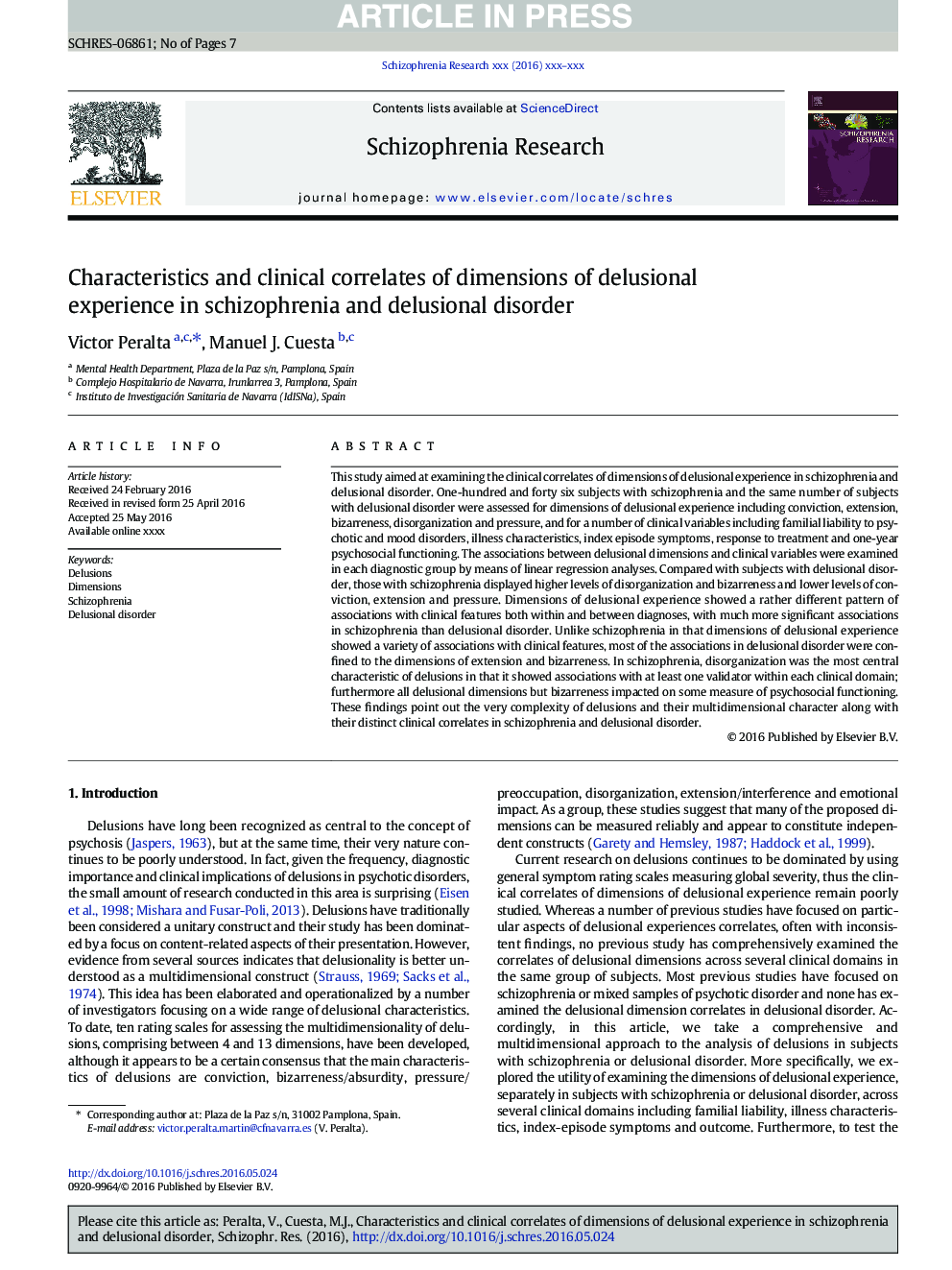| کد مقاله | کد نشریه | سال انتشار | مقاله انگلیسی | نسخه تمام متن |
|---|---|---|---|---|
| 4935206 | 548001 | 2016 | 7 صفحه PDF | دانلود رایگان |
عنوان انگلیسی مقاله ISI
Characteristics and clinical correlates of dimensions of delusional experience in schizophrenia and delusional disorder
ترجمه فارسی عنوان
ویژگی ها و همبستگی بالینی ابعاد تجربه دلخوری در اسکیزوفرنی و اختلال دلخواه
دانلود مقاله + سفارش ترجمه
دانلود مقاله ISI انگلیسی
رایگان برای ایرانیان
کلمات کلیدی
اتهامات ابعاد جنون جوانی، اختلال دلخواه،
ترجمه چکیده
هدف از این مطالعه بررسی همبستگی بالینی ابعاد تجربه دلبستگی در اسکیزوفرنی و اختلال دلخواه است. شصت و شش فرد مبتلا به اسکیزوفرنیا و همان تعداد افراد مبتلا به اختلال دلخواه برای ابعاد تجربه دلخوری از جمله اعتقاد، تمایل، بی عارضه، بی نظمی و فشار و برای تعدادی از متغیرهای بالینی شامل مسئولیت خانوادگی به روانپریشی و خلق اختلالات، ویژگی های بیماری، علائم عوارض شاخص، پاسخ به درمان و یک ساله عملکرد روانی و اجتماعی. ارتباط بین ابعاد ذاتی و متغیرهای بالینی در هر گروه تشخیصی با استفاده از تحلیل رگرسیون خطی مورد بررسی قرار گرفت. در مقایسه با افراد مبتلا به اختلال دلبستگی، افراد مبتلا به اسکیزوفرنی سطح بالایی از اختلال نعوظ و بی عارضه و سطوح پایین تر اعتقاد، گسترش و فشار را نشان دادند. ابعاد تجربه دلخواه نشان دهنده الگوی نسبتا متفاوتی از ارتباط با ویژگی های بالینی در بین تشخیص ها و بین آن ها بود و ارتباطات بسیار مهمی در اسکیزوفرنیا نسبت به اختلال دلبستگی داشت. بر خلاف اسکیزوفرنی که در آن ابعاد تجربه دلبستگی، ارتباطات گوناگونی با ویژگی های بالینی نشان داد، بیشترین ارتباطات در اختلال دلخواه محدود به ابعاد گسترش و بی عدالتی بود. در اسکیزوفرنی، اختلال نعوظ، یکی از مهم ترین ویژگی های تصورات است که نشان دهنده ارتباط با حداقل یک اعتبار سنج در هر حوزه بالینی است. علاوه بر این، همه ابعاد ذاتا، اما عجیب و غریب در برخی از اندازه گیری از عملکرد روانی و اجتماعی تاثیر گذاشت. این یافته ها نشان می دهد که پیچیدگی های گمراه کننده و شخصیت چند بعدی آنها به همراه همبستگی بالینی متمایز آنها در اسکیزوفرنی و اختلال دلخواه مشخص شده است.
موضوعات مرتبط
علوم زیستی و بیوفناوری
علم عصب شناسی
علوم اعصاب رفتاری
چکیده انگلیسی
This study aimed at examining the clinical correlates of dimensions of delusional experience in schizophrenia and delusional disorder. One-hundred and forty six subjects with schizophrenia and the same number of subjects with delusional disorder were assessed for dimensions of delusional experience including conviction, extension, bizarreness, disorganization and pressure, and for a number of clinical variables including familial liability to psychotic and mood disorders, illness characteristics, index episode symptoms, response to treatment and one-year psychosocial functioning. The associations between delusional dimensions and clinical variables were examined in each diagnostic group by means of linear regression analyses. Compared with subjects with delusional disorder, those with schizophrenia displayed higher levels of disorganization and bizarreness and lower levels of conviction, extension and pressure. Dimensions of delusional experience showed a rather different pattern of associations with clinical features both within and between diagnoses, with much more significant associations in schizophrenia than delusional disorder. Unlike schizophrenia in that dimensions of delusional experience showed a variety of associations with clinical features, most of the associations in delusional disorder were confined to the dimensions of extension and bizarreness. In schizophrenia, disorganization was the most central characteristic of delusions in that it showed associations with at least one validator within each clinical domain; furthermore all delusional dimensions but bizarreness impacted on some measure of psychosocial functioning. These findings point out the very complexity of delusions and their multidimensional character along with their distinct clinical correlates in schizophrenia and delusional disorder.
ناشر
Database: Elsevier - ScienceDirect (ساینس دایرکت)
Journal: Schizophrenia Research - Volume 176, Issues 2â3, October 2016, Pages 404-410
Journal: Schizophrenia Research - Volume 176, Issues 2â3, October 2016, Pages 404-410
نویسندگان
Victor Peralta, Manuel J. Cuesta,
